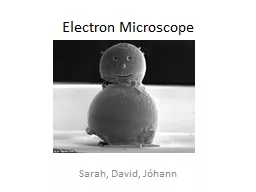

Jóhann The electron source Thermionic emission Wolfram LaB 6 CeB 6 can be used instead Field emission Cold Field Schottky Thermionic emission Thermal energy is used to allow the electrons overcome the work function releasing them to form an electron beam ID: 932370
Download Presentation The PPT/PDF document "Electron Microscope Sarah, David," is the property of its rightful owner. Permission is granted to download and print the materials on this web site for personal, non-commercial use only, and to display it on your personal computer provided you do not modify the materials and that you retain all copyright notices contained in the materials. By downloading content from our website, you accept the terms of this agreement.
Slide1
Electron Microscope
Sarah, David, Jóhann
Slide2The electron source
Thermionic emissionWolframLaB6
[CeB
6
can be used instead]
Field emission
Cold Field
Schottky
Slide3Thermionic emission
Thermal energy is used to allow the electrons overcome the work function, releasing them to form an electron beam.
Requires material with a very high melting point (
Wolfram, 3695 K
) or a low work function (LaB
6
, 2.4 eV)Richardson’s Law: Where J is the current density in A/m2, T is in Kelvin, and AG is Richardson’s constant (A/m2K2)
Slide4Field emission
The emission of electrons induced by an electrostatic fieldThe theory is described approximately by the Fowler-Nordheim equations, which strictly speaking apply only to field emissions from bulk metals.
A prime example of electron tunneling
Slide5Field emission, cont.
In order to function properly at ambient temperatures, the surface must be contamination and oxide free – this is achieved by operating under high vacuum conditions (<10-11
Torr
) – called cold field emission.
A poorer vacuum can be used by heating the tip, and the thermal energy also assists in electron emission.
Slide6In these cases, the surface is covered with
ZrO to improve the emission characteristics.These ZrO coated electron guns are called
Schottky
emitters.
Slide7Electron-beam lithography
Using a focused beam of electrons to draw custom shapes on an electron sensitive film. [“exposing”]This changes the solubility of the affected area, enabling selective removal of either the exposed or non-exposed areas by solvent immersion. [“developing”]
Primary advantage of e-beam lithography is the custom pattern with <10 nm resolution, although due to its low throughput, usage is limited.
Slide8Electron Sources
Thermionic sources are sufficient when high resolution is not required.When it is, field electron emission sources are preferred due to their lower energy spread and enhanced brightness.
Within the field emissions, thermal assisted is preferred over cold, despite the former’s slightly larger beam size, due to greater stability over long periods of time.
Slide9Throughput
Minimum time to expose a given area for a given dose:
Where T is the time to expose the object,
I is the beam current, D is the dose and A
is the area exposed.
Slide10Throughput, example
Assume:
E
xposure area (A) of 1 cm
2
Dose (D) of 10
-3 C/cm2Beam current (I) of 10-9 AT=106 s (approximately 11.5 days)For the 700 cm2 surface of a 300 mm silicon wafer, minimum writing time is just over 22 years.
Slide11Quantitative Analysis
In order to do quantitative analysis, the surface of the material being measured must be flat.
X-rays must travel through the material above them in order to be detectable – the greater the distance, the more of an effect this has on the energy.
In order for this effect to be consistent, the distance traveled through the material must remain constant – which is achieved by having a flat surface.
Slide12Qualitative Analysis
The detector for the X-rays involves the use of a silicon crystal.The photons hit the crystal, releasing electrons which are then counted.Counting these electrons takes time, which means there is a speed vs. accuracy tradeoff.
Slide13Qualitative Analysis, cont.
The spectra are a combination of two things – the characteristic peaks used for identifying elements, and the continuous background spectra, which ranges from zero up to the beam voltage.
The background radiation is a result of the deceleration of beam electrons as they travel through the material.
Slide14Slide15Slide16Slide17Slide182D representation of chemical composition along a line